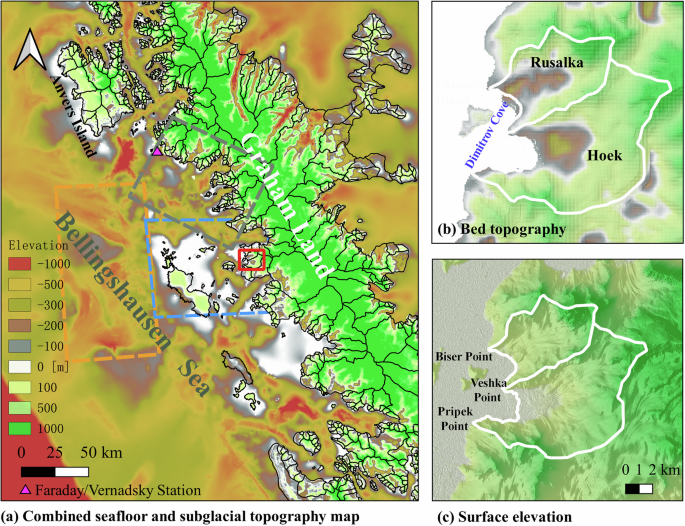Why Do Neighboring Glaciers Behave So Differently? New Clues from the Antarctic Peninsula
Published in Earth & Environment
At first glance, neighboring glaciers flowing into the same bay should respond similarly to environmental change, because they share the same atmosphere, ocean, and regional geography. Yet in our new study of the western Antarctic Peninsula, we discovered that two glaciers just a few kilometers apart, Hoek Glacier and Rusalka Glacier, are telling two very different stories about how climate and ocean forcing shape glacier behavior.
A rapidly changing region
Over the past decades, the Antarctic Peninsula has been one of the fastest-warming regions on Earth. Glaciers there are retreating, thinning, and accelerating under the influence of warming ocean water that melts their floating fronts from below.
To understand how neighboring glaciers can behave so differently under the same regional climate pressures, our team analyzed nearly three decades of satellite data (1990–2025, with dense coverage after 2000), including optical and radar imagery from Landsat, Sentinel-1, Sentinel-2, and TanDEM-X missions. We manually traced calving front positions; tracked surface velocity and surface-elevation changes; estimated grouding line positions; and monitored sea-ice extent in front of each glacier.
Two glaciers, two very different stories
Hoek Glacier underwent major calving-front retreats that followed reductions in sea-ice cover. Yet despite these retreats, its surface elevation remained relatively stable during a key observational window (2012–2017). Rusalka Glacier, right next door, remained largely stable at the front in the early 2010s. However, between 2014 and 2017, it experienced pronounced thinning.
These contrasting behaviors challenge the common assumption that neighboring glaciers should respond similarly to external forcing. Instead, they reveal that local conditions that not just regional climate can dominate glacier response.
The hidden stabilizer: sea ice
One key factor emerges from our analysis: sea ice, though seemingly tenuous and ephemeral, can act as a crucial stabilizer.
When dense sea ice forms and persists in front of a glacier, it acts like a natural brace: suppressing ocean waves, limiting iceberg calving, and mechanically stabilizing the calving front. At Hoek Glacier, which sits in a sheltered embayment, seasonal sea-ice cover tends to persist longer than at Rusalka. When sea ice is abundant, the calving front remains constrained and advances only modestly. But once sea ice declines, the front surges, and the small ice shelf becomes stretched and mechanically weakened. Persistent reduced sea-ice conditions may trigger collapse or rapid inland retreat.
In contrast, Rusalka Glacier with less persistent sea ice and more exposure to open water shows no consistent link between sea-ice variability and calving-front position. Instead, its behavior appears to be governed by local bed geometry and ocean circulation, factors that do not provide the transient stabilizing brace that sea ice afforded Hoek.
In short: sea ice isn’t just a passive bystander when geography allows it to accumulate in front of a glacier; its presence or absence can tip the balance between stability and retreat.
Ocean forcing and local bed constraints
Remote-sensing observations show clear divergence between the two glaciers during 2014–2017. Rusalka Glacier thinned substantially between 2014 and 2017 based on satellite-derived surface elevation data. Its surface velocity increased notably in 2016 and 2017, followed by sustained calving-front retreats starting in early 2017. Mapping of temporally consistent features also suggests that Rusalka’s grounding line position in 2017 retreated relative to 2014. In contrast, Hoek Glacier remained comparatively stable, exhibiting only minor changes in surface elevation and limited grounding line fluctuation within the same observation period.
Ocean reanalysis products indicate that the core layer of warm Circumpolar Deep Water was anomalously shallow in 2016 and 2017. In combination with glacier-specific bed topography, we observe that Rusalka’s terminus and grounding zone reside on a locally retrograde bed, a setting that may favor stronger frontal thinning when warm water access increases. This supports the inference that shallow warm water anomalies preceding 2017 could have contributed to the enhanced basal melting and the subsequent calving-front and grounding line retreats at Rusalka.
At Hoek Glacier, however, multi-year grounding line positions inferred for 2012, 2014, and 2017 are all located on a forward-inclined bed slope near the terminus, where frontal geometry may provide more sustained mechanical support and reduce sensitivity to transient warm water shoaling.
Local heterogeneity conditions glacier sensitivity
Together, neighboring Antarctic outlet glaciers Hoek and Rusalka illustrate that adjacent marine-terminating glaciers can evolve along divergent pathways even within a broadly similar regional climate and oceanic setting. Remote-sensing records show that local physiographic factors near the terminus, including seafloor topography, fjord geometry, and the seasonal persistence of sea ice, create distinct boundary conditions that shape how each glacier margin expresses sensitivity to environmental variability. This reinforces that improving future projections requires better observational constraints in frontal and grounding-zone regions, rather than broader regional averages or qualitative assumptions.
Follow the Topic
-
Communications Earth & Environment

An open access journal from Nature Portfolio that publishes high-quality research, reviews and commentary in the Earth, environmental and planetary sciences.
Related Collections
With Collections, you can get published faster and increase your visibility.
Geology of the Moon
Publishing Model: Hybrid
Deadline: Jan 31, 2026
Archaeology & Environment
Publishing Model: Hybrid
Deadline: Mar 31, 2026



Please sign in or register for FREE
If you are a registered user on Research Communities by Springer Nature, please sign in